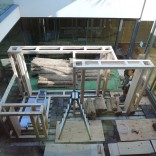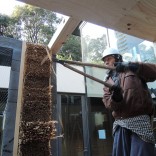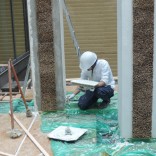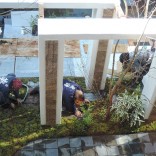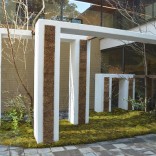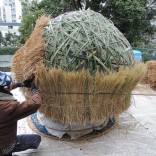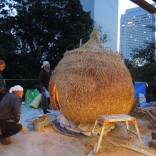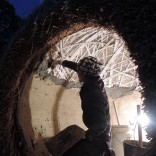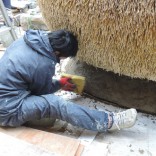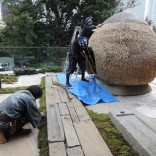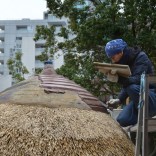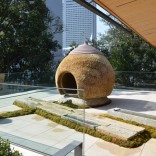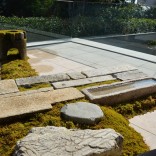Opening Event "Public Production of Objects by Young Craftsmen" |
① "+-one (plus minus one) fragrance world" ... B1F courtyard |
First of all, a wooden frame is assembled, and Sagara-san gradually packs kaya (reeds) into the frame. There is no other example of using such a kaya, and Sagara seems to be the first challenge. |
The construction of Sakan plasterers began when the kaya was cut straight. First, a base is made on the outside of the wooden frame, and cement and white plaster are applied on it. The finish is elegant white with the image of snow. In the cold winter, the phenomenon called "Hakka", which turns whitish in the process of the painted soil drying, occurs, so it is said that it was white. |
The last is a gardener led by Mr. Yamaguchi. Plants related to Sho-chiku-bai and tea (ume, ryobu, Kumazasa, Okamezasa, pine, chanoki) are arranged and spread moss. |
Simple kaya and soil objects were complemented by plants, and the courtyard of floor tiles and clay walls became a slightly different atmosphere than usual. |
②"LENS" ... 1F Terrace |
The base of bamboo knitting that has been made in advance is set up, and thatch is laid outside. There is no thatched spherical thatched in Japan, and of course Sagara also tried for the first time. The roofing (top) makes your head cute and sharp. But it would leak rain, so I decided to entrust the top to Mr. Tsukura of Sakan plasterers. |
Mr. Tsukura paints the soil on the inside of the base. |
The foundation and floor are also Sakan plasterers's work. I will paint it carefully. |
The gardeners made the way to the entrance, with square stones and moss, and Chozubachi in front of the entrance.
|
Mr. Tsukura, who was not satisfied with the design of his head and painted it many times, finished it in a row like acorn at once. |
The water praised on the garden stone reflects the scenery, and the expression changes depending on the viewing angle and time. Mr. Yamaguchi says that water represents various lights and landscapes that come into the lens. |
It was fun for the viewers to create this object, but I think the craftsmen themselves enjoyed the most. I feel like I saw the "remnants of Japan" in the appearance of craftsmen competing for skills, challenging new things, and worried. Japanese traditional culture must have been created in this way.
|
| Return to the main page |
